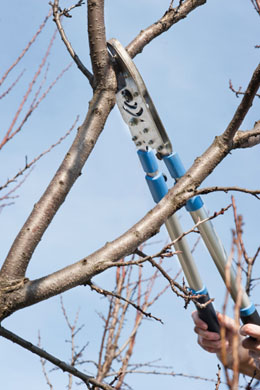Pruning is beneficial for making plum trees strong and healthy, and produce a good amount of fruits. Here is a simple guide for pruning these trees.

Plum trees are often grown for their attractive blossoms and delicious fruits. Apart from watering and feeding, pruning is also important for the health of plum trees. It also makes the trees productive, but pruning should be done at the proper time and in a proper manner. Plum trees are pruned and shaped like a vase, fan, or pyramid. Such shaping is good for letting in the sunlight to almost all parts of the tree. While such detailed pruning is done during the early years of the tree, regular pruning is an easier task.
Best Time to Prune Plum Trees
It is better to prune maiden trees (a tree in the first year of budding or grafting) during the spring. If the tree is already 2 to 3 years old when you purchase it, then pruning can be done one year after planting. Pruning can expose plum trees to silver leaf disease, caused by a fungus that enters the tissues through the open cuts in the stems.
Pruning in the winter or early spring can make the tree vulnerable to this disease. This does not apply to small trees, as the cuts are relatively small as compared to that of large trees. The larger the trees, the larger the cuts caused by pruning. So it is advisable to wait till late spring or early summer. The dry weather helps protect such established plum trees from this disease.
How to Prune a Plum Tree
Pruning fruit trees is not a difficult task, provided you know the basics regarding the time of pruning, what to prune, and how to prune. In case of larger, established trees, pruning means thinning of the overcrowded branches to ensure free passage of sunlight. More detailed pruning is done during the early years of planting, when you have to give a framework to the tree.
- Always make sure that the cuts are clean, without causing any splitting or fraying of the wood. In case of cuts which are two inches or less in size, there is no need of protective sealant; but for large cuts, you can either use a sealant or prune with a slant that points towards the tree. These measures can ensure prevention of water damage.
- While pruning plum trees, always remember to remove dead or damaged branches, and those parts that look sick or dying.
- The manner of pruning must be based on your idea of growing plum trees. If you want a bush plum tree in future, you should prune the baby tree three feet above the soil. If you want a big plum tree, then pruning should be done four feet above the soil. For a pyramid-shaped one, you must prune the baby tree just two feet above the soil.
- You must make the cut just above the buds, and each cut must have at least one bud below them. In case of a baby plum tree, make sure that there are a few buds below the cut. During the second season of pruning, the cut should be 18 inches above a bud on the main stem. Other branches should be pruned to around 10 inches. Pruning should be repeated every year for better results.
Plum trees should not be pruned during mid-summers, as it can coincide with the fruiting season. In that case, the tree may concentrate on foliage growth rather than fruiting. Likewise, pruning in winter makes the trees susceptible to silver leaf disease. This is due to the damp weather during that season. You should also ensure proper removal and disposal of the pruned branches, to prevent spread of the disease. Pruning is essential for the proper growth of plum trees, and for a good yield.






 Plum trees are often grown for their attractive blossoms and delicious fruits. Apart from watering and feeding, pruning is also important for the health of plum trees. It also makes the trees productive, but pruning should be done at the proper time and in a proper manner. Plum trees are pruned and shaped like a vase, fan, or pyramid. Such shaping is good for letting in the sunlight to almost all parts of the tree. While such detailed pruning is done during the early years of the tree, regular pruning is an easier task.
Plum trees are often grown for their attractive blossoms and delicious fruits. Apart from watering and feeding, pruning is also important for the health of plum trees. It also makes the trees productive, but pruning should be done at the proper time and in a proper manner. Plum trees are pruned and shaped like a vase, fan, or pyramid. Such shaping is good for letting in the sunlight to almost all parts of the tree. While such detailed pruning is done during the early years of the tree, regular pruning is an easier task.